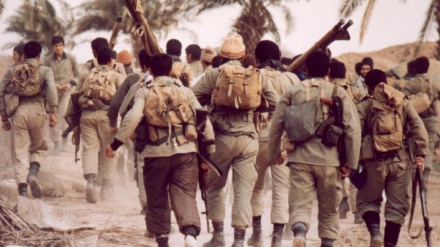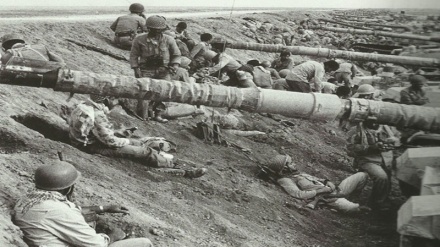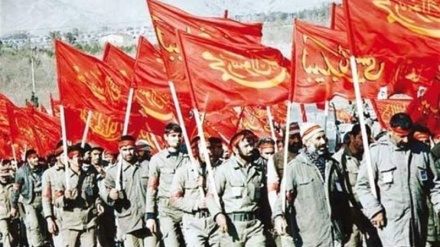Glimpses of Epic of 8-Year Holy Defense (1)
Although nearly three decades have passed since the 8-year holy defense of the Iranian nation against the US-imposed war through its stooge Saddam, many aspects are still untold about the epic, valour and devotion of the Iranian combatants. This series of programs is an effort to show some of these aspects to the new generation. Hope you'll enjoy it.
On September 22, 1980, the Iraqi Baathist regime started an all-out assault on Iran from the ground, sea and air. A few days before the invasion, Saddam had torn up the 1975 Algiers Border Agreement in front of the Iraqi official TV cameras. In the first wave of the Baathist army attacks, the airports of Tehran, Ahwaz, Tabriz, Hamedan, Bushehr and Abadan were bombed. The people of border cities like Khorramshahr and Abadan woke up with the explosion of artillery and tank shells. Thus an 8-year war was imposed on the newly-established system of the Islamic Republic of Iran. As Iraq’s attacks on Iran’s western and southern borders escalated, people from all strata declared their readiness to be sent to the battle front. The founder of the Islamic Republic Imam Khomeini, in a message condemned the attack and warned about the continued aggression of Saddam regime on Iran’s territory.
Part of the message read: "A madman has come and thrown a stone and left. Do not think that the Iranian nation, government and army are unable to answer this. When the need comes I will give a message to the nation and they will prove to Saddam and the like of him that we will give them the answer."
The invasion was launched just 19 months after the victory of the Islamic Revolution. At that time, the Islamic Republic was confronting the internal and external plots and threats. The Iranian army was reconstructing itself after the overthrow of monarchic regime. The Islamic Revolution Guards Corps (IRGC) was in early stages of formation. But just within one year after the onset of the Iraqi invasion, the army and the IRGC with the wide popular support regained their power and launched several surprise attacks and gained victory in numerous fronts; thus the Baathist regime in Iraq was forced to adopt defensive position. Moreover, in some regions, the united forces of army, IRGC and Basij volunteers pushed the invaders back to the international borders.
The Western-imposed war of Saddam which was aimed at overthrowing the newfound system of the Islamic Republic of Iran turned into a source of strength, unity and national solidarity of the Iranian people. The 8-year war was one of the unique epic and eternal periods in the history of the Islamic Revolution of Iran. Iranian People, especially the youths, with minimal facilities and military equipment showed to the world one of the most lasting epics and exemplary displays of valour in defending the country and the revolution. This epic and valour turned into a model for the freedom-seeking movements across the world. The Islamic resistance in Lebanon, Palestine, Iraq, Syria, Yemen and so on stems from self-sacrifice and martyrdom of the Iranian Muslim youths.
Over 200,000 Iranian youths were martyred courageously in defending the lofty values of the Islamic Revolution. The brave Iranian youths did not hesitate a single moment to sacrifice their life in the path of God to liberate the Islamic land from the clutches of the occupiers; hence even an inch of the Iranian soil didn't remain in the hands of the enemy. War is always destructive for all countries, but when a country is invaded by a cruel enemy and the youths of the invaded country rise up wholeheartedly to defend the country and the sacred system, they create unforgettable manifestations of bravery, valour, epic, self-sacrifice and honour. The leader of the Islamic Revolution, Ayatollah Seyyed Ali Khamenei, says: "This war was defensive. Defensive war is different from aggressive war. In defensive war human beings expresses their deep-rooted loyalty and attachment to the ideals to which they are bound."
The 8-year holy defense of the Iranian nation against the savage aggression of the enemy, which enjoyed the full support of the western and eastern blocs, became the infinite source of national pride for the Iranian people. The 8-year imposed war was indeed the defence of an oppressed nation against the eastern and western powers who had brought their state-of-the-art military weapons and ammunitions to bring the Islamic Republic of Iran to its knees. The bravery of the Iranian youths showed that a system of government with popular support and in the light of Islamic rule and unity of forces can defeat any enemy regardless of the power of the enemy or how many superpowers support it. The Iranian people, under the leadership of a unique leader motivated with religious and national spirit rose up against the enemy and displayed their national unity. These motivations were the reason for the nationwide and enthusiastic presence of Iranian people in religious, ideological and national battlefronts. The eight-year defense was an honorable battle. Therefore, the Iranian combatants did not violate human and Islamic criteria in the face of the dastardly enemy who didn't spare any opportunity to apply internationally banned weapons, bombing and firing missiles on the cities and infrastructures of Iran.
In all countries, defending the soil and common values of a nation have always inspired devoted and committed artists. With a short glance at Iranian art, literature, cinema, painting and so on, one realizes that the best and the most qualified works belong to the periods that this nation has withstood against the aggression and greed of the enemies and ill-wishers of the country. Accordingly, the 8-year holy defense of Iranian people against the repressive Ba'ath minority regime of Saddam is an immortal gushing spring of Islamic values and national unity and solidarity. This undying spring continues to inspire the Iranian artists more than ever to create unique and picturesque works of art. The 8-year holy defense of the Iranian nation inspired the Iranian people so much so that it has impacted the free-spirited people beyond the borders of Iran and inspired many oppressed nations.
The Iranian youths' 8-year selfless combat against Saddam army, which enjoyed the support of at least 58 countries, has not been properly noticed by many people. Recounting of the events of the 8-year holy defense can always inspire Iran and the freedom-seekers of the world as it has stabilized the position of the Islamic Republic of Iran in the region and the world.
Understanding the regional and trans-regional consequences of the 8-year holy defense is not so difficult. The regional and international aspects of 8-year holy defense were much broader and effective than the post-World War Two wars and conflicts. In the past 400 years, several wars took place between Iran and the Ottoman Empire while Iraq was part of the Iranian territory but one cannot consider these wars equal to the invasion which seemed to be launched by a single regime; whereas it was actually orchestrated, funded and supported by all regional and international big powers, especially the Great Satan (the US) and then Soviet Union.
Many strategists believe that the 8-year holy defense of Iranian people against the aggression of Saddam regime was the first modern warfare. But with the divine motivation and national unity and solidarity without reliance on foreign powers, the Iranian nation triumphed over the armed-to-the-teeth enemy to the chagrin of hegemonic powers. But why and how did Saddam dare stage a long war against the Islamic Republic of Iran? Territorial and border disputes between Iran and Iraq have long existed and this was not the reason for attack on Iran’s territory. They were just an excuse for Saddam to invade Iran. In fact, what emboldened Saddam to attack Iran was the victory of the Islamic Revolution and its impacts on the regional and global equations.
Saddam, who on one hand sensed his regime at the stake of overthrowing by a popular uprising a la Iran and on the other hand was indulged in the illusion of turning to the gendarme of the region and ruler of the Arab world, was beguiled by big powers to flex his muscles to overthrow the nascent Islamic system in Iran. The developments after the victory of the Islamic Revolution were detrimental to both super powers and their regional satellites. The war imposed by Saddam on the Islamic Republic was one of the reactions to the Islamic Revolution. We will further discuss the issue in the next program.
RM/SS


